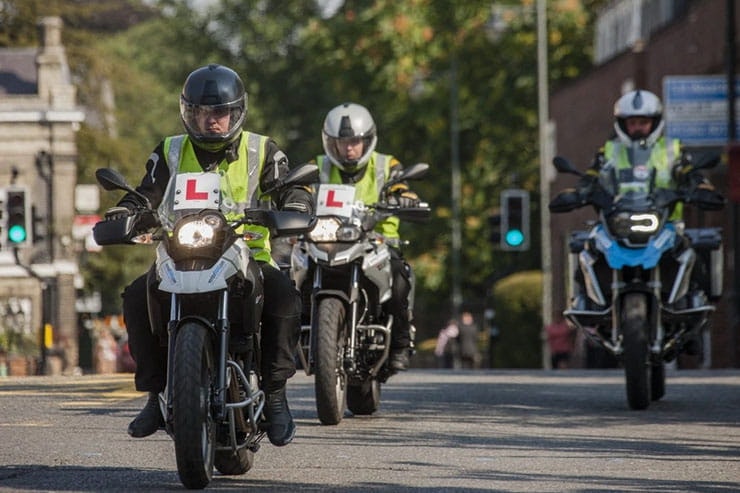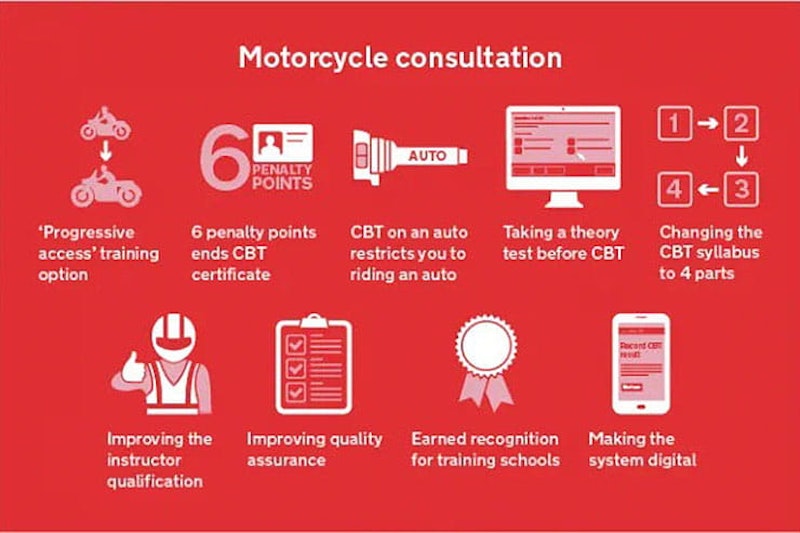Motorcycle industry calls for changes to CBT
By Ben Purvis
Motorcycle Journalist
18.07.2023
Branches of the motorcycle industry in the UK including the Motorcycle Industry Association (MCIA) and National Motorcyclists Council have linked with Transport for London and road safety charities to call for changes to motorcycle training that were promised more than five years ago.
Back in 2016 the Department for Transport carried out a consultation titled Improving Moped and Motorcycle Training, that was intended to find ways to do exactly that. The results, created with contributions from across motorcycling in the UK, were published in December 2017, showing overwhelming support for an array of updates to the training regime. And since then… virtually nothing has happened.
The changes that the motorcycle industry believe are essential to improve both safety and the path that new riders take into motorcycling include the introduction of a training course to upgrade motorcycle licence entitlements, allowing new riders to move up to larger, more powerful bikes via progressive training rather than by taking additional practical tests, as they must at the moment.
The consultation results also supported the introduction of an automatic-only version of CBT that restricts riders to twist-and-go models, the introduction of an option to upgrade that entitlement via additional training, and the revocation of CBT certificates for riders with six or more penalty points.
All these were agreed in 2016/2017, but it’s been more than five years, and none have been implemented.
The plan also included several key updates to the CBT syllabus including a requirement for trainees to wear appropriate kit and a condensation of the five current CBT elements to four. The theory test was also proposed to be taken prior to the CBT to ensure that riders, even those on L-plates, all know the basics of road rules before they’re out there with traffic.
From an administrative perspective, the 2016 consultation also brought up several improvements including the creation of a new instructor qualification, allowing them to qualify for both CBT and DAS (direct access scheme) training in one step rather than two. There were also proposals for improving quality assurance of motorcycle instructors and digitising the CBT administration process.
To encourage the Government to get on with the changes that were agreed more than half a decade ago, the MCIA, NMC, TfL and several road safety charities have penned a joint letter to the Secretary of State for Transport, Mark Harper, calling for progress on the plan.
Craig Carey-Clinch, Executive Director of the NMC, said: “The changes we call for in our joint letter today were agreed by Government several years ago and their introduction is long overdue. We urge the Secretary of State and the Department for Transport to commence work to implement this positive and potentially life-saving legislation.
“Our letter to the Secretary of State marks a moment when the motorcycle sector, public authorities and road safety organisations have come together to achieve positive change for motorcycle safety. We urge the Government to take note and act in partnership with all parties to make these changes to CBT and also to other areas of motorcycle safety, so that a more sustainable and proactive approach can be taken to support casualty reduction for this important mode of mobility, transport and leisure.”
1. Changes to CBT
The current CBT has five elements: a) eyesight, aims and equipment, b) practical on-site training, c) practical on-site riding, d) motorcycle theory and e) on-road practical riding. The 2016 consultation envisaged combining b) and c) into one, reducing it to four elements, with the majority of respondents backing the idea. Other revisions suggested included new steering control exercises and theory instruction on filtering, with more than 85% of respondents in favour. Beyond that, there were calls to allow instructors to refuse CBT to pupils without suitable clothing, as currently the only requirement is a helmet, with more than 95% backing the idea.
In its response, the Government said: “The new syllabus will also contain additional competencies. This will lead to more focused customer centred assessments, and better preparation for riding in real road conditions. There will be greater emphasis on riders wearing the right protective motorcycle clothing from the outset, as they begin their training, in order to encourage riders to regard such equipment as an inherent part of safe riding on the road.
“We intend to introduce these changes when time allows.”
2. Licence upgrade path
Getting from nothing to a full motorcycle licence is a convoluted, multi-stage process involving multiple tests and a variety of age limits at the moment – particularly for riders under 24 years old – but the 2016 consultation suggested a ‘Progressive Access’ route to a full licence, using at least seven hours of additional training to progress from a restricted A2 licence to an unlimited one. This was already allowed under EU licence rules when the current arrangement was introduced but hasn’t been implement here yet. In its 2017 response to the consultation, the government said: “We intend to explore the costs and feasibility of introducing progressive access training and will consult more fully once these factors have been considered.”
3. Restricting learners to automatic bikes if they take their CBT on one
This one does what it says on the tin. At the moment you could undergo CBT on a twist-and-go scooter, with both brakes on the bars and no foot controls or clutch, and then jump straight on a manual transmission bike and venture onto the road. A recipe for disaster, given that clutch control and gear-changing are among the finer arts of riding.
In 2016, more than 84% of respondents to the consultation agreed this needs to change with the introduction of an autos-only CBT category for riders who only want to use scooters, and an upgrade path for those who start on autos and then want to switch to manuals.
4. Six points to revoke a CBT
This one is logical, too. If you’ve passed your motorcycle test within the last two years, you’re automatically limited to six licence points before you’re automatically disqualified and forced to resit the test. But for riders on L-plates who’ve only undergone basic training, there’s no such restriction. Introducing a six-point limit leading to a revoked CBT certificate would simply bring it into line with a full licence, particularly as CBT certificates are only valid for two years anyway.
The limiting factor here appears to be an administrative one, as in 2017, despite more than 83% of respondents backing the change, the DVSA’s response was that it would ‘explore’ the idea, but that it would probably “require DVLA system changes to record the removal of CBT.”
5. Theory test before CBT
Again, this seems sensible. Knowing the theory of using the road before actually using it isn’t asking a huge amount from CBT candidates, but at the moment a theory test is only required before the motorcycle test itself – something that many L-plate riders might never take.
Back in 2017 the DVSA’s response to overwhelming support for introducing a theory test before the CBT was: “We… intend to introduce the requirement for all learner riders to pass their motorcycle theory and hazard perception test before completing CBT.
“This would ensure better theoretical knowledge, allow more time for practical training during the CBT course and may encourage more learner riders to go on and take the full test, rather than riding as a learner on a CBT certificate.”
It still hasn’t happened yet, though.
If you’d like to chat about this article or anything else biking related, join us and thousands of other riders at the Bennetts BikeSocial Facebook page.
Share on social media:

